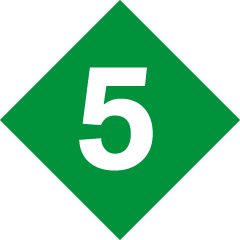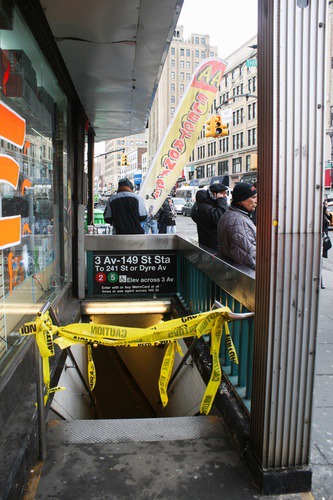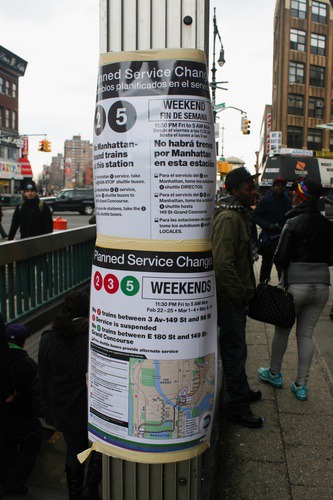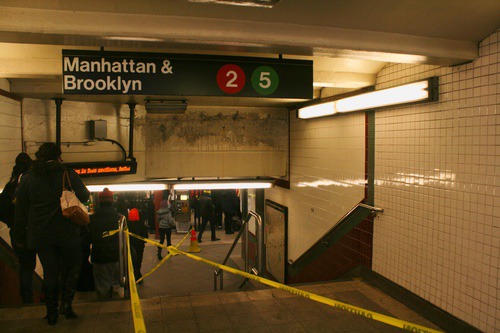











3 Avenue-149 Street today appears to be a simple underground station in the Bronx with two side platforms for the two-track line just north – directionally east – of the station, the two subway tracks slowly curve outside and becoming elevated for the rest of their journey north on the White Plains Road Line. It is located under the Hub, the primary shopping district of the Bronx and is the borough’s second busiest subway station.
Until April 29, 1973 the station was the transfer point to the southern terminus of what remained of the 3rd Avenue elevated, its Bronx Portion. This included a now abandoned underpass within the station that once led to a transfer structure through a building up to the elevated structure. In 1973 the elevated was replaced by the Bx55 bus, which was a limited, elevated-replacement bus route. This bus only stopped at the former elevated stations up to Gun Hill Road (that also had a connection to the elevated) with a free (and then very rare, only other examples were for other elevated lines that had recently closed) subway-bus transfer to the Bx55 using paper transfers. In 1992 this connection was used to prototype MetroCard transfers (with people needing to swipe/dip them for the first time). Any special transfers to the Bx55 were eliminated with the introduction of MetroCard Gold, allowing one free subway/bus transfer, on July 4, 1997. The Bx55 was eliminated for good on June 30, 2013, replaced by the Bx41 SBS north of Fordham Plaza (which continues to the Hub down Webster Avenue, a parallel street to Third Avenue), and the Bx15 Limited south of Fordham Plaza.
There were also track connections just after the station after the tunnel portal before the next subway stop at Jackson Avenue. Slightly wider trackways in this area still provide some evidence of these former track connections The original track connection (used to provide all service from November 26, 1904 until this station opened on July 10 , 1905) was a short elevated line along 150 Street, serviced by trains after they stopped at the 149 Street Station. An additional track connection used in passenger service, designed to reduce congestion at what was a simple flat junction, was built as part of the dual contracts in 1916. This was the Bergen Avenue cutoff that allowed elevated trains to skip the 149 Street stations. Trains ran along this cutoff from 1916 until 1946, before it was removed in 1950. It was used primarily by rush hour Second Avenue elevated trains (replaced by Third Avenue Elevated trains, after the Second Avenue Elevated closed in 1941) that ran up to Freeman Street before terminating. South of the Bergen Avenue cut-off, all the way to just south of the Second Avenue bridge and 129th Street in Manhattan, the Second and Third Avenue elevateds in the Bronx ran on a combined double-deck 4 track elevated structure.
The current station’s two side platforms were renovated in 1996, which included the removal of all terra-cotta plaques. These platforms today have red circular columns and walls with a very ‘90s design of tall white tiles, with a small red border up above, and a red lower-portion with a small green trimline. There are no name tablets anymore, just black with white text signs that say 3 Avenue-149 Street.
The station has one open exit located in the middle of the platforms. Each of the two fare control areas have a unique circular design with the turnstiles slightly set back from the platforms in a circular shape, behind the turnstiles the token booths are directly built into walls of the station. For exits, the uptown platform has an elevator and staircase up to the SW corner of Third Avenue and 149 Street. A short staircase leads up to two streetstairs up to the SE corner.
The Downtown platform has a staircase and elevator to the NW corner of Melrose Avenue, there is an abandoned staircase up to this corner. There is also a short staircase that splits into two at an intermediate landing, this leads up to two streetstairs up to the triangular block formed by Melrose Avenue ending at 149 Street, nearly at the intersection of Third Avenue. The streetstairs are all a 1990s silver pillars, with silver tops as the streetstair design. The elevators are the original generation with glass blocks design.
Photos 1: February 10, 2004; 2-4: March 24, 2007; 5-12: February 24, 2013;
Arts For Transit at 3 Av-149 St
Una Raza, Un Mundo, Universo (One Race, One World, One Universe), 1996, Glass Mosaic Murals on Platform Walls
By José Ortega


